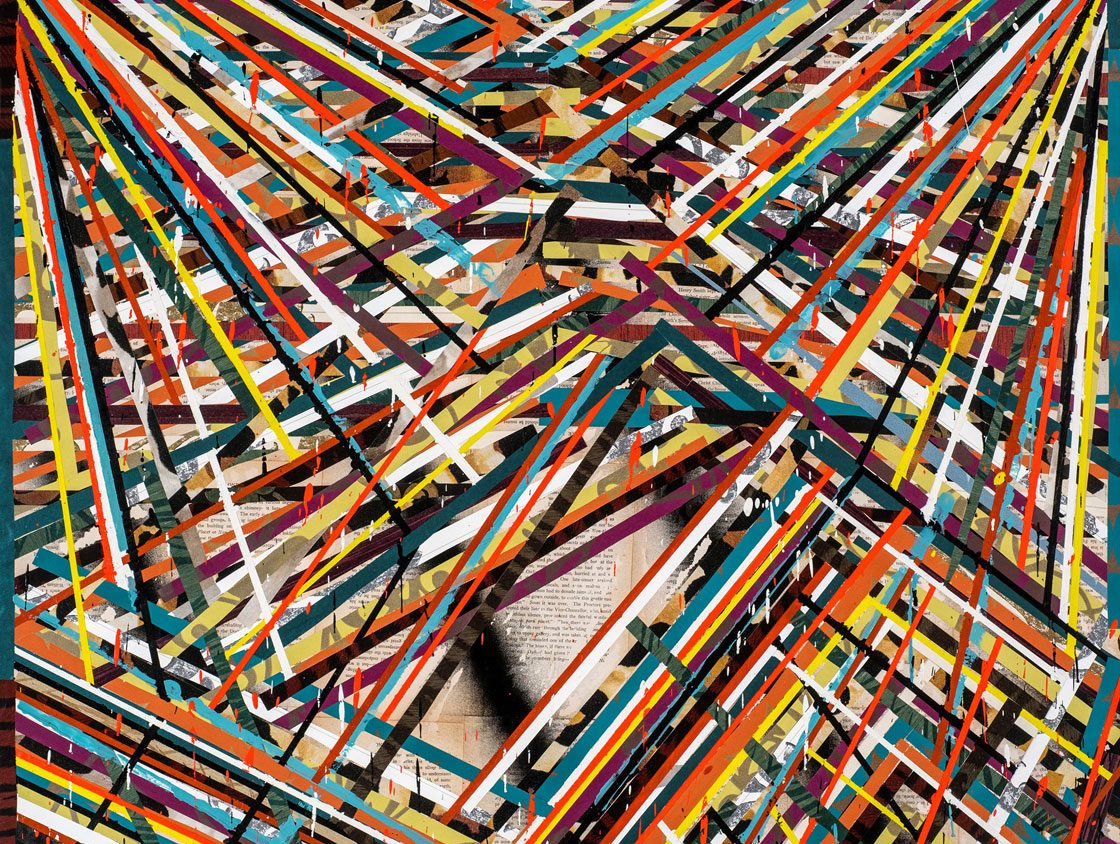Steven Broocks doesn’t know a whole lot about Towards a 21st Century Abstraction, the exhibit currently showing through Dec. 4 at the Coos Art Museum, where he serves as executive director. He has never met the curator, Peter Frank, and doesn’t even have Frank’s contact information. One of the eight participating artists in the show organized the exhibit, he says, but he couldn’t get hold of her, either. It’s almost as if the California-curated show appeared in Coos Bay by magic.
Seeing the exhibit, it sort of feels that way, too. This is due in part to the sheer presence of the artworks on display. Shown in three galleries on the first floor of the museum — a former post office which was built as a WPA project in 1936 — the paintings have a sculptural or three-dimensional quality to them. Constructed as much as painted, they are put together with acrylic and oils but also wax, paper, fabric, text and texture.
The show was curated in southern California but features artists from around the country. They are David Bailin (Little Rock, Arkansas), Connie Connally (Santa Barbara, California), Brad Ellis (Dallas, Texas), Jeri Ledbetter (Nashville, Tennessee), Katherine Chang Liu (Westlake Village, California), Sammy Peters (Little Rock, Arkansas), Doug Trump (Marlboro, Vermont) and Wosene Worke Kosrof (Berkeley, California).
Ledbetter and Ellis work on opposite sides of the spectrum in terms of color, but both use contrasting elements in their art. Ledbetter says her oil, crayon and graphite compositions “are an interplay between focused areas of color and nervous, even kinetic wiry lines.” Yes, you can see these contrasting features, but what fascinates me most about her largely monochromatic paintings is her use of white on white. It’s satisfying to see different values of a single color on a surface at once. It reminds me there are choices, even for a so-called non-color like white. And the variations are endless.
Ellis’ works get about as far from white as imaginable. His extraordinarily colorful paintings are done with encaustic, a process using hot wax. In an age where conceptual art reigns, Ellis’ pieces give you something beautiful to look at, brilliant colors laid on thick. This is not to say there aren’t thought-provoking images behind the pigment. “Rolling” is a triptych, a painting in three panels done in encaustic and enamel. The outside panels are heavy masses of thick stripes, a completely abstract design. In contrast, thin, neat stripes run across the center panel, and beneath them is text. The lines of copy read like they could have been lifted from a book on art. I’m not sure. But that’s the point: the text is obscured, the art is not.
Michael Ferguson is not a part of the 21st Century Abstraction exhibit. Working from Tacoma, Washington, he has his own show upstairs at the museum, Michael Ferguson: Landscape Journey 1992-2021. I am including it here because his landscape paintings have a pleasing abstract edge to them. Moving through Ferguson’s artworks, I recognize influences of different modern painters: Vincent van Gogh, Gustav Klimt and Georges Seurat.
Ferguson is self taught, but it’s likely he studied these modern artists. Copying works by great masters is a typical method of studying art. As a beginning drawing student I was introduced to Leonardo da Vinci when I was told to copy one of his drawings. And I see evidence of the Impressionists and Post-Impressionists in Ferguson’s work. Seurat’s stipples and van Gogh’s dashes populate his paintings, and “Roundabout Wildflower Mix” is an acrylic work whose design reminds me of Klimt’s “The Kiss.” These influences are noticeable but merge into a single vision that is uniquely Ferguson.
The trip upstairs to the second floor is totally worth it.
So is the one from Eugene to Coos Bay. I don’t think I’m overstepping when I say that Coos Bay is not known for being an arts center. Viewing these abstract paintings, though, it felt like I was in Santa Fe’s Railyard District more than downtown Coos Bay.
I’ve heard it said that you know a movie or a book is good if it sticks with you. Returning to Eugene, Ferguson’s unexpected landscape colors — oranges, reds and greens — followed me back. Driving east on Highway 126, Ellis’ brilliant contrasts of patterns appeared along the sides of the road in the way light shone through the branches of trees. I saw Ledbetter’s interplay of monochromatic variations in the many yellows of the leaves.
So, that’s pretty good.
Towards a 21st Century Abstraction and Michael Ferguson: Landscape Journey 1992-2021 run through Dec. 4 at the Coos Art Museum, 235 Anderson Ave., Coos Bay. A closing reception will be held from 3 to 5 pm Dec. 4. Museum hours are 10 am to 4 pm Tuesday through Friday and 1 to 4 pm Saturday. Admission is $5, $2 students and seniors.
